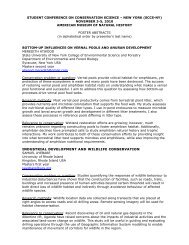PDF - American Museum of Natural History
PDF - American Museum of Natural History
PDF - American Museum of Natural History
- No tags were found...
You also want an ePaper? Increase the reach of your titles
YUMPU automatically turns print PDFs into web optimized ePapers that Google loves.
Project: Our Global Kitchen Exhibit: Cooking Table Date: 9/19/12 thickens. Season to taste. Recipe Add salt and pepper, whisk. -‐-‐-‐ Fixing a Broken Sauce If you add the fat too fast, the water and fat will Content -‐-‐ Click on button to move to next step. stop mixing and break apart. To fix a “broken sauce,” throw an ice cube into the mixture and whisk around it. Simmer! Action Button 3 2 inches <strong>of</strong> water Recipe Bring a new pot filled with water, -‐-‐-‐ turn on the heat. + 1 Tbsp. vinegar Recipe Add a swig <strong>of</strong> vinegar to the pot. -‐-‐-‐ Vinegar and Eggs Many chefs mix vinegar into the water when poaching an egg. The vinegar reacts with the egg white, helping it retain its shape better. But it can also cause a film to form around the egg xv Bring to a simmer. Content -‐-‐-‐ Click on button to proceed to next step. Poach! Action Button 4 very fresh eggs Recipe Crack an egg into a ramekin salt s<strong>of</strong>t simmer Recipe Slide egg into the water. Slowly slide egg. Cook until Recipe Cook egg. still wobbly. 5-‐6 minutes. Egg Temperature The proteins in eggs are very sensitive to Content -‐-‐-‐ Click on button to proceed to next step. temperature—the difference one or two degrees can change the texture <strong>of</strong> a cooked egg. At 145.4 ˚F (63 ˚C) a poached egg has a runny yolk. If the egg reaches 149 ˚F (65 ˚C), the yolk becomes a s<strong>of</strong>t solid xvi . Plate! Action Button 5 -‐-‐ -‐-‐ Set table. Remove egg with a slotted spoon. Serve over toast. -‐-‐
















